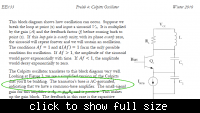samy555
Full Member level 4


(1) How much the ratio C2/C1 should be in order to start oscillations?
(2) If the output signal is taken from emitter through a suitable capacitor, how will be the feedback path to the base if the transistor?
(3) We all know that there is a stray capacitance came of external connections and the internal capacity of the transistor itself. If I use a 2n3904 transistor which has the following data:

My question is how much capacitance I should add to the series C1 and C2?
(4) Are there any effects from Cc cap on the oscillation frequency?
Thanks














